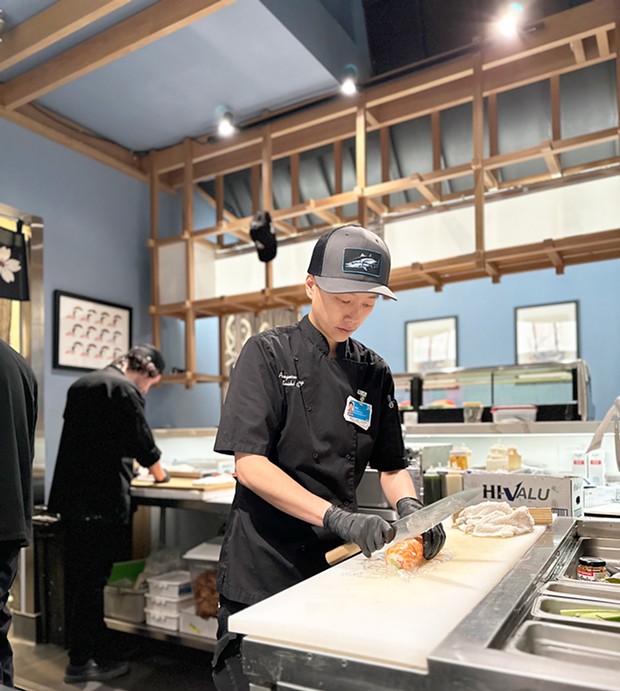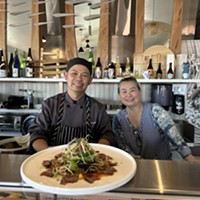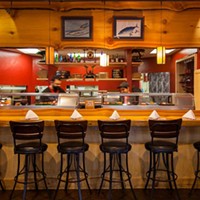Chef Pangnou Vang Behind the Counter at Sushi Blue
By Jennifer Fumiko Cahill [email protected] @jfumikocahill
Photo by Jennifer Fumiko Cahill
Pangnou Vang slices a Kyoto Dragon Roll at Sushi Blue.
[
{
"name": "Top Stories Video Pair",
"insertPoint": "7",
"component": "17087298",
"parentWrapperClass": "fdn-ads-inline-content-block",
"requiredCountToDisplay": "1"
}
]
Pangnou Vang's face is mostly hidden under the bill of her ballcap as she works, angling the blade of her long, wooden handled knife horizontally along a block of salmon belly. The fingers of her other hand rest lightly on top of the fish, following the shape of the knife like a peaking wave as it slices a thin layer below.
When she finally looks up, a customer might mistake Vang for someone younger than her 34 years or, like others, underestimate her experience behind a sushi counter. But 16 years after she first trained at the original Kyoto Japanese Restaurant, she's helming Sushi Blue at Blue Lake Casino.
One of 14 children born to Hmong American immigrants in Fresno, Vang moved to Humboldt County at the age of 9. "My parents were in the Secret War," she says. Like many Hmong people, they fled Laos, where the U.S. carried out covert operations during the Vietnam War. "They swam across the river, stayed in a refugee camp in Thailand," she says, a journey not all her family members survived.
"Normal kids, they grow up playing house. I grew up learning how to cook in the kitchen — I was learning to make rice," says Vang. As soon as she was old enough to work outside the home, she got a job in food service. After stints at KFC and Liu's Oriental Cuisine in her early teens, she started washing dishes at Kyoto under Kyoko and George Clark. "Oh man, [Kyoko] would yell at me if I put the plates down too loud," she recalls with a laugh. As rare as female sushi chefs are in the industry at large, Vang notes there were three women working the line at the restaurant.
When Eric and Jeni Masaki bought the restaurant and renamed it Masaki's Kyoto Japanese Restaurant, Vang stayed on, at first as a server. "Then they realized I am a horrible waitress," she admits frankly. "I was a kid and I didn't know how to talk to people, and I had a sailor's mouth." At 18, she couldn't serve alcohol, so the bosses tried her out behind the counter under Evangeline Johnson, who's now a chef at Sushi Spot, and Noelani Davis. Once she got rolling, literally and figuratively, she stayed for a decade.
Three years working in Portland at as many restaurants, including a sushi boat place and a pair of fine dining establishments, didn't entice Vang to stay. Working with all-male crews under traditional Japanese chefs — in terms of patriarchy, if not cuisine — was frustrating. "They were definitely not having me as a part of their team," she says. "I'm also gay, so that's even worse." As male dominated as the restaurant industry has historically been, the realm of sushi is even more so. "I've worked with a lot of guys just belittling me like I shouldn't be a sushi chef because I'm a woman. My hands are too warm to touch the fish," she says, citing an old sushi shop adage that makes one wonder how much contact its proponents have with actual women.
"Like, did your dad cook you rice? I don't think so," quips Vang, noting the irony of women being relegated to kitchens in the home but discouraged from chef work is common enough in Asian and Western cultures. "In Hmong culture, the women always eat last. They cook and eat last," she says, describing how she and her mother, aunts and sisters cooked while the men in the family drank and talked at the table until the food came. When the women and girls did eat, it was standing or wherever they could find a spot.
Back in Humboldt, Vang worked in the cannabis industry during the pandemic until the market fell. She then returned to making sushi at Sushi Spot, where she says she learned a great deal from longtime chef Junko Otani. "I tried to run away from the restaurant world but something kept pulling me back in," says Vang. "It's a passion of mine to create art out of food."
Hoping for a spot at Sushi Blue, Vang says she took work at Blue Lake Casino's Alice's restaurant, eventually working under sushi chef Jacob Talbert for nearly a year before his departure. Taking over the role of executive chef and the menu she'd inherited was a bit sudden, but she felt ready.
"I have a lot of fun building and creating menu [items] and teaching people skills," says Vang, who adds she doesn't mind investing in young staff who might take their new skillset elsewhere. "I wanna create a safe environment for people to learn and be at their best, because if I behave like a drill sergeant, no one's gonna stick around."
Vang knows Sushi Blue has loyal regulars and is not looking to make big menu changes anytime soon. But she is adding items and specials that reflect her tastes and aesthetic. "I like to do more of a traditional style. I lean more toward the fish and less sauce because that's what I was taught," she says. "You wanna taste the fish — you don't want it to be overwhelmed with sauce." Still, she recognizes that for diners in Humboldt, as in Portland, more heavily sauced rolls are popular. "If I'm gonna use a sauce, I want it to go with the fish."
Those nostalgic for Kyoto Japanese Restaurant will be pleased with the occasional revival of the Kyoto Dragon Roll, which she learned to make at the start of her career there ($23). It's bright, nori-less and lightly sauced, as American-style sushi goes. The tempura shrimp inside is still warm and crispy against the creamy avocado and the pop of tobiko. On top, transparent slices of lemon and modest dots of spicy mayonnaise balance the fatty salmon.
Vang's sashimi plates showcase her knife skills and the flavor of buttery, barely torched Hamachi belly, ahi and salmon, again paired with lemon ($26). Recently, she's started curing egg yolks with salt and miso. "It just elevates anything you put it on," she says. Over maguro nigiri, the light yellow curls could be mistaken for cheese, but for the flavor and texture as it melts on the tongue, adding creamy dimension and a little salt to the leaner tuna.
Diners who typically skip the usual perfunctory ice cream dessert would do well to consider Vang's Japanese-style cheesecake — not the wiggling variety that's lately gone viral, but its firmer cousin made with whipped egg whites and baked in a water bath ($9). Under the edge of a spoon, it gives and crumbles, but against the tongue it melts with mild sweetness and the tang of cream and goat cheeses. On a recent evening, an individual milk chocolate cheesecake came topped with whipped cream and drizzled with a shiro miso caramel. The miso lent it an earthy intensity and a bite of salt different from the usual sea salt flakes. It is not to be underestimated.
Jennifer Fumiko Cahill (she/her) is the arts and features editor at the Journal. Reach her at (707) 442-1400, extension 320, or [email protected]. Follow her on Instagram @JFumikoCahill
Speaking of...
-

Look Up for Rooftop Sushi
Apr 19, 2024 -

Transparency, Newspapers and Sushi
Mar 23, 2024 -

Sushi Spot’s Tipping Point
Feb 6, 2024 - More »
more from the author
-
SCOTUS on the Homeless, CPH Protest and Local Entertainment
- Apr 26, 2024
-
Look Up for Rooftop Sushi
- Apr 19, 2024
-
Resentencing, CASA Kids and Freaky Fish
- Apr 19, 2024
- More »

































